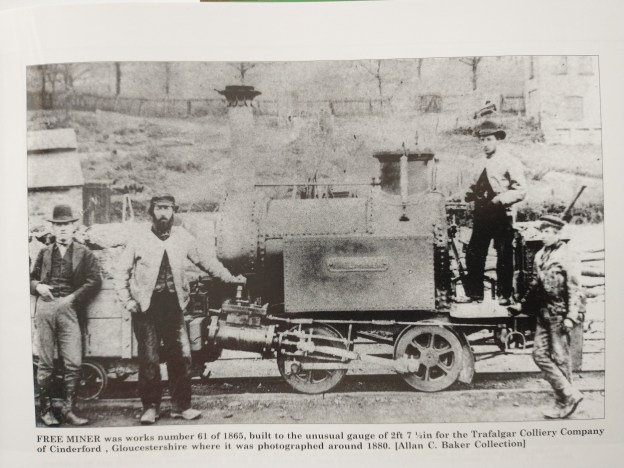The featured image above shows the locomotive ‘Free Miner’ which was Works No. 61, at the Lilleshall Company Works, it was delivered to Trafalgar Colliery in February 1865 for use on the Tramway. The picture comes from Bob Yate’s book about the Lilleshall Company locomotives and railways, (c) Alan C. Baker Collection. [5: p55]
A little while ago, I wrote an article about the Trafalgar Colliery in the Forest of Dean and as part of that article started to cover Brain’s Tramway. That article can be found at:
Trafalgar Colliery and Railway
In that article, I noted that Brain’s Tramway was built soon after the opening of the colliery to connect to the Great Western Railway’s Forest of Dean Branch at Bilson [1] The single line of 2ft 7.5in gauge utilised edge rails laid on wooden sleepers and ran east from the colliery, turning south-east at Laymoor, and terminated 1.5 miles away at interchange sidings at Bilson. It would appear that the authorisation for its construction was a Crown licence for ‘a road or tramway 15 feet broad’ dated May 1862. The date the line was opened for traffic is unknown as, although the first of three locomotives used on the tramway was built in 1869, it is possible that it may have been horse worked before this date. [2]
I noted that the colliery appeared to have owned three locomotives: ‘Trafalgar’ and ‘The Brothers’ were 0-4-2 side-tank locos. The third locomotive was ‘Free Miner’, an 0-4-0 side-tank. The locomotive ‘Trafalgar’ continued in use until 1906, working on the northern extension of the tramway, built in 1869, to the Golden Valley Iron Mine at Drybrook. [2] we will return to these three locomotives later in this article.
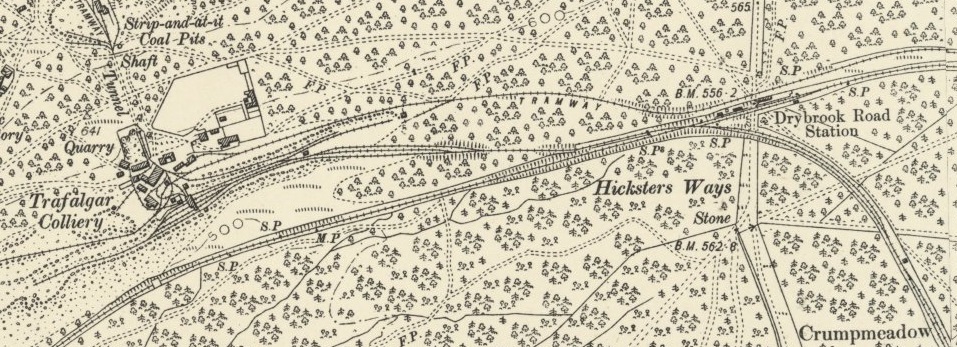
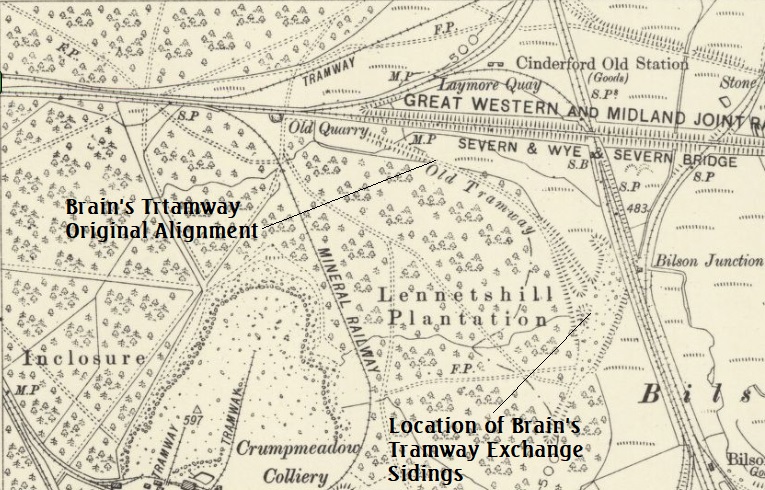
Tramway locomotives hauled trains of 20-25 trams of coal on each trip along Brain’s Tramway to Bilson, until 1872 when the Severn & Wye built their branch to Bilson. This crossed the tramway on the level near Laymoor and resulted in the need for the two companies to negotiate an acceptable coexistence. This became more urgent once the Servern and Wye extended beyond Drybrook Road an when, in 1878, passenger trains began running over the crossing.
Although a connection had been made to the Severn and Wye Railway in 1872 [1] at a point between Serridge Junction and Drybrook Road station, a large element of Trafalgar’s output still travelled along the tramway to Bilson. [2]
In my article about the colliery, I noted that in 1872, agreement was reached between the Severn and Wye and Trafalgar Colliery for sidings to be put in to serve the colliery screens. Soon after the Mineral Loop of the Severn and Wye was completed, a loop off the main line was installed and sidings were laid. However, the Severn and Wye was dismayed to note at a later date that Trafalgar Colliery was still making heavy use of the tramway.
The Lightmoor Press website comments that:
“Finally, in December 1889, an agreement was entered into between the Severn & Wye and the Trafalgar Colliery Company who, it was said, ‘are desirous of obtaining railway communication to Bilson Junction in lieu of their existing trolley road.’ It was agreed that on or before 31st March 1890 the colliery company would construct new sidings and the railway company would lay in a new junction at Drybrook Road. Although the new junction was a quarter of a mile closer to Drybrook Road than the old sidings, the mileage charge was to remain the same. The accommodation, on approximately the same level as Drybrook Road station, was to be constructed so that traffic to and from the Great Western would be placed on a different siding to that which was to pass over the Severn & Wye system. For taking traffic to Bilson Junction for transfer to the Great Western the colliery was to be charged 7d per loaded wagon, although empties were to pass free. The transfer traffic also had to be conveyed ‘at reasonable times and in fair quantities so as to fit in with the ordinary workings of the Railway Company trains’. The new sidings were brought into use on 1st October 1890.” [2]
The Lightmoor Press article notes that this “agreement finally resulted in the abandonment of the length of the tramway from Laymoor to Bilson Junction. Two of the colliery’s narrow gauge locomotives were put up for sale, neither sold.” [2]
A couple of things:
1. More about the locomotives in use on Brain’s Tramway
Further research has resulted in a bit more information about the locomotives that worked on the Tramway. ….
These locomotives were built by the Lilleshall Iron Co. The first, ‘Free Miner’ was built in 1865. I came across the locomotive in a book by Bob Yate, “The Railways and Locomotives of the Lilleshall Company.” [5] I have recently (2022) moved to Telford and I have been reading a number of publications about the industry, canals, tramways and railways of the area. The Lilleshall Company was the major player in the industrial scene in the Telford (East Shropshire) area throughout the 19th century and much of the 20th century. It had its own system of canals, tramways and railways. Ultimately it had a large roster of industrial locomotives. In the mid-19th century, the Lilleshall Iron Co. built locomotive for others. Bob Yates features ‘Free Miner’ in his list of locomotives built by the Lilleshall Company.
‘Free Miner‘ was Order No. 61 at the Lilleshall Works. It was built in 1865 to a 2ft 7.5 in gauge. It was an 0-4-0T locomotive which the Industrial Railway Society Handbook records as having 8″ x 14″ outside cylinders. It was delivered new in February 1865 to Cornelius Brain, Colliery, Cinderford, Gloucestershire. It was possibly scrapped in 1906. [5: p52]
The date of delivery calls into question the comments above about the date of opening of the line as we now know that a single locomotive was available early in 1865, rather than in 1869. Given that approval for the construction of the Tramway was only given in 1862, it may well be that it was only operated under horsepower for a very short period.
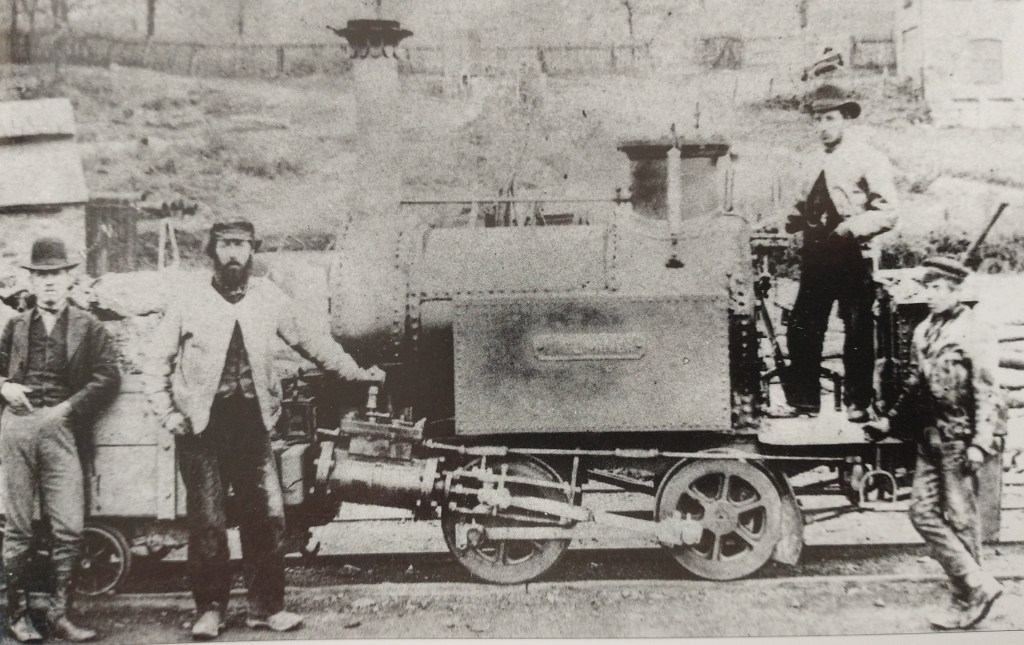
Bob Yate also provides information about the other two locomotives ‘Trafalgar’ and ‘The Brothers’. ‘Trafalgar‘ was supplied to the colliery in 1869. Bob Yates provides the following information: Gauge 2ft 7.5in; Works No. 140; 0-4-2T with 8″ x14″ outside cylinders. It was delivered new in April 1869. Yate comments that an early photograph of this locomotive reveals that it was supplied without a cab, and that the trailing wheels were only about 6″ diameter less than the driving wheels. The safety valves were mounted on a ‘haystack’ firebox. Scrapped c 1906. [5: p56] Both Yate [5: p56] and Lightmoor [2] say the the locomotive was of an 0-4-2T wheel arrangement. What seems not to have been noted is the very short wheel-base of the locomotive as can be seen in the image below. Also evident is the minimal difference in size between the driving wheels and the trailing wheels that Yate refers to.
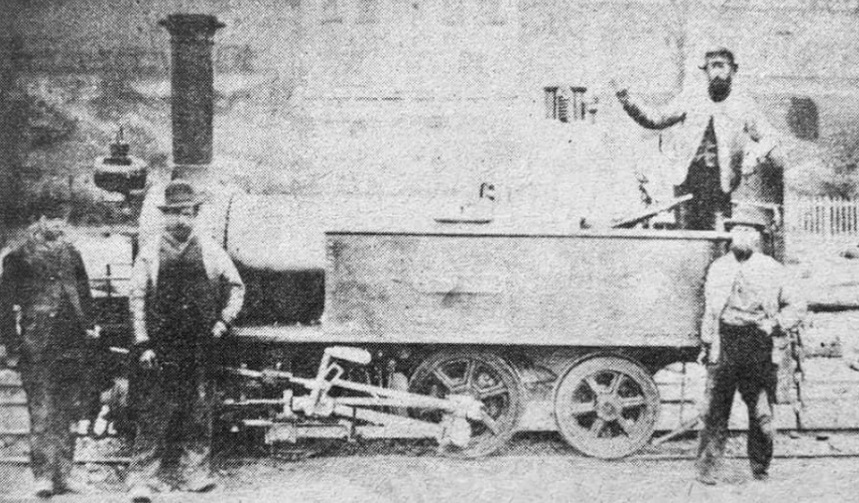
‘The Brothers‘ was delivered new by the Lilleshall Company in August 1870. It was Order No. 159 on the Lilleshall Company books. Yate records this as a sister locomotive to ‘Trafalgar’ with the same details/dimensions. He notes, however that the Register of Drawings in the archives of the Ironbridge Gorge Museum Trust has the cylinder bore being 8.5in diameter. [5]
2. The Northern Extension
A brief mention, on the Lightmoor Press website, of ‘Trafalgar’ being used on the tramway’s northern extension, [2] encouraged a look at that section of the tramway.
When I was writing about the Trafalgar Colliery, [6] I did not have access to the 1878/79 Ordnance Survey of the Forest which was published in 1883. That shows the transshipment sidings at Bilson junction, the Laymoor crossing and the erstwhile Bilson Road Station. It also shows the northern extension of the tramway diverging from the line to the transshipment sidings just to the North of Bilson Road Station.
The tramway branch was built in 1869/70. It “ran north to the Golden Valley Iron Mine near Drybrook. … The earthwork remains of embankments, cuttings and the interchange embankment are visible on aerial photographs.” [8]
“The tramway earthworks divide in two at its eastern end, the northern branch heading towards Drybrook, the southern heading towards Bilson Interchange.” [8]
“The Brain family used clay from Trafalgar colliery at brickworks at Steam Mills.”[12][13] The tramway “ran northwards by way of Steam Mills and Nailbridge to iron-ore workings near Drybrook. In 1890 the Severn & Wye provided Trafalgar with a line to Bilson but the narrow-gauge railway continued to carry coal to Steam Mills and Nailbridge.” [13][14]
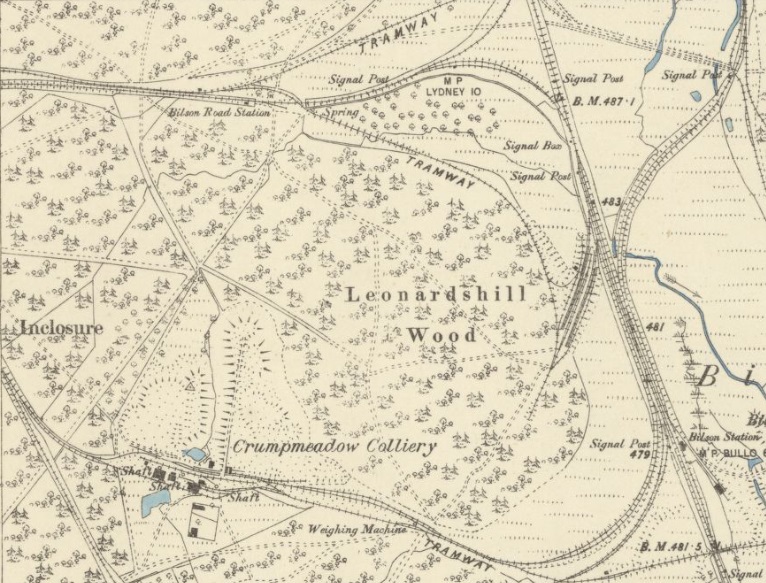

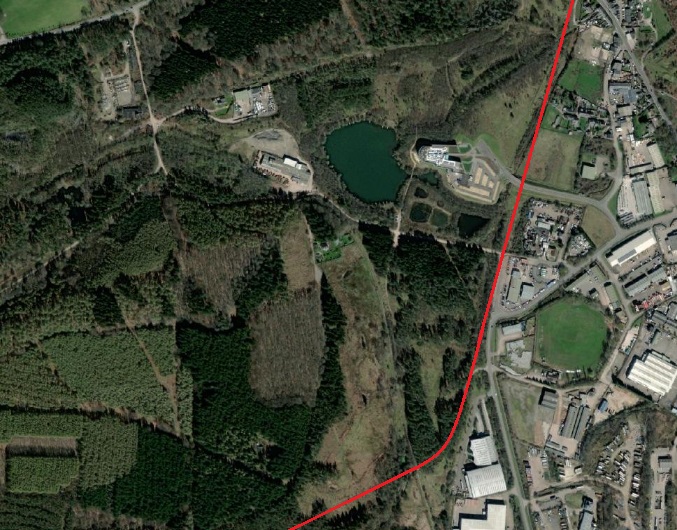
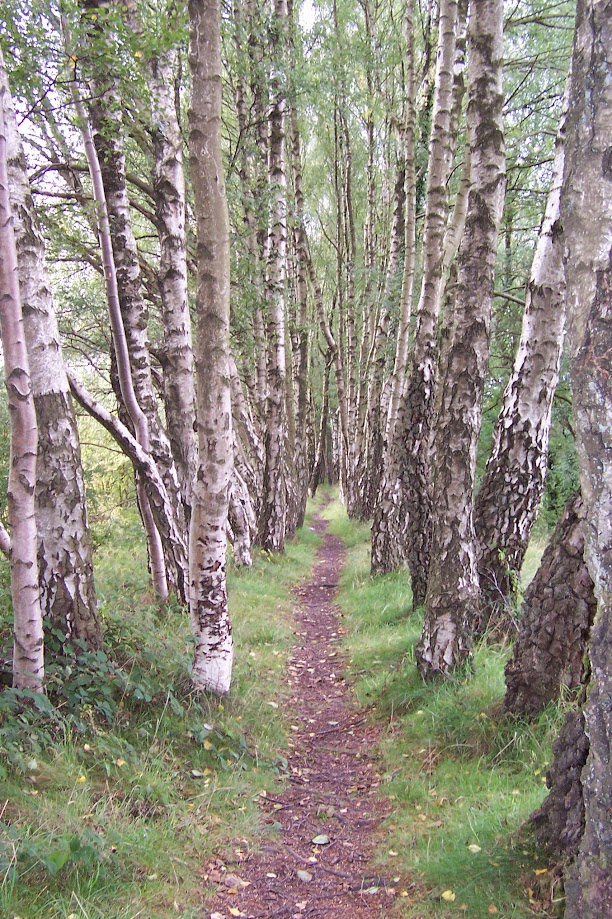
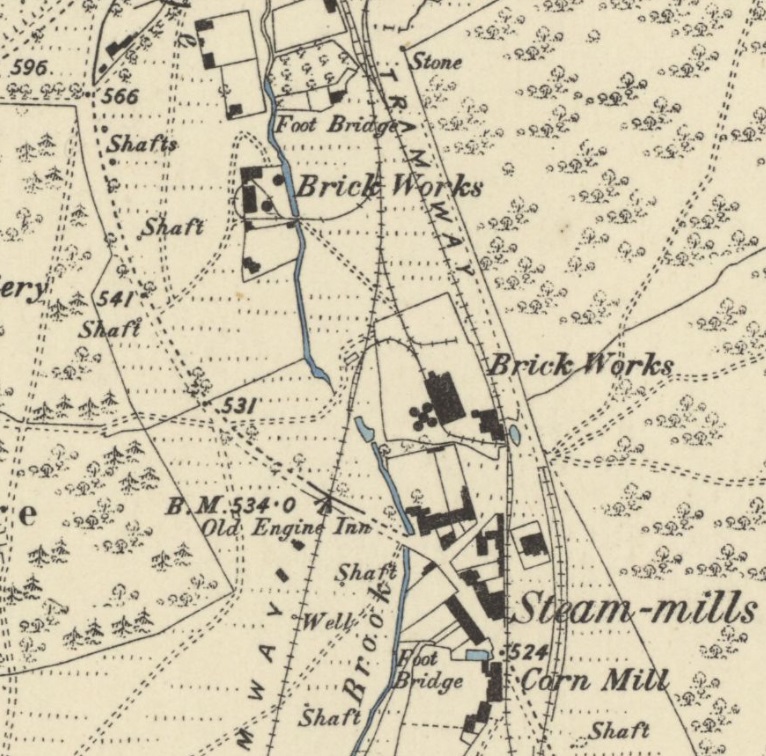
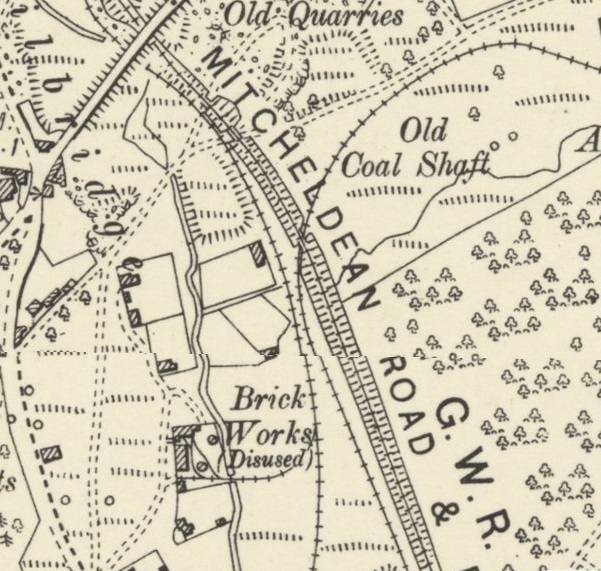
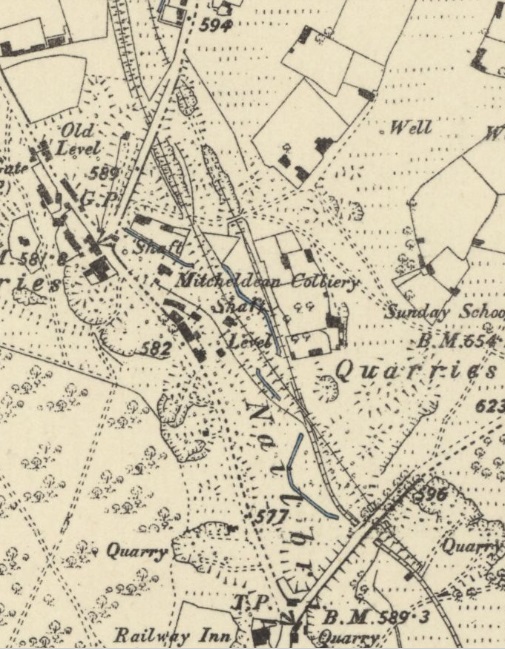
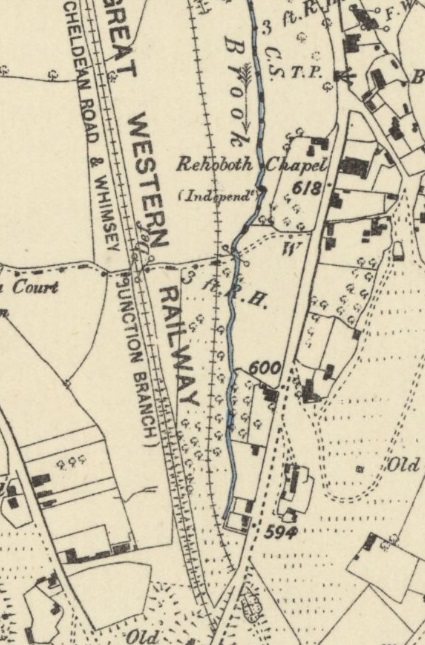
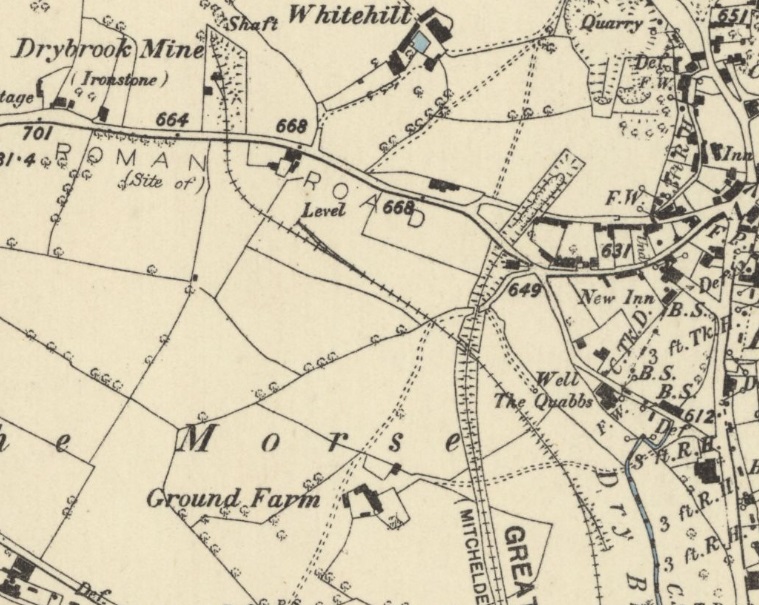
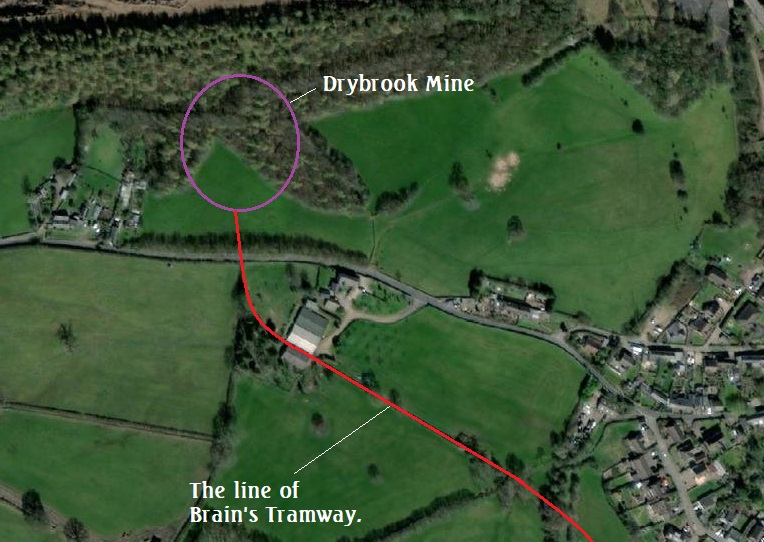
References
- https://www.forestofdeanhistory.org.uk/resources/sites-in-the-forest/trafalgar-colliery, accessed on 30th August 2019.
- http://lightmoor.co.uk/forestcoal/CoalTrafalgar.html, accessed on 30th August 2019.
- https://maps.nls.uk/view/101453394, accessed on 20th September 2019.
- http://www.industrialgwent.co.uk/wuk12c-fodne/index.htm, accessed on 24th September 2019.
- Bob Yate; The Railways and Locomotives of the Lilleshall Company; Irwell Press, Clophill, Bedfordshire, 2008.
- https://maps.nls.uk/view/101453397, accessed on 15th June 2022.
- https://maps.nls.uk/view/101453373, accessed on 15th June 2022.
- https://www.heritagegateway.org.uk/Gateway/Results_Single.aspx?uid=1386093&resourceID=19191, accessed on 25th June 2022.
- https://maps.nls.uk/geo/explore/#zoom=15.821121422997756&lat=51.84498&lon=-2.51483&layers=6&b=1, accessed on 25th June 2022.
- https://maps.nls.uk/geo/explore/#zoom=15.821121422997756&lat=51.83884&lon=-2.51419&layers=6&b=1, accessed on 25th June 2022.
- https://maps.nls.uk/geo/explore/#zoom=15.821121422997756&lat=51.83247&lon=-2.51658&layers=6&b=1, accessed on 25th June 2022.
- The Public Records Office (P.R.O., F 3/402) consulted by British History Online, https://www.british-history.ac.uk/vch/glos/vol5/pp326-354#h3-0008, accessed on 25th June 2022.
- https://www.british-history.ac.uk/vch/glos/vol5/pp326-354#h3-0008, accessed on 25th June 2022.
- Paar, G.W.R. in Dean, p145-8; Gloucester Records Office (D 262/T 1) consulted by British History Online, https://www.british-history.ac.uk/vch/glos/vol5/pp326-354#h3-0008, accessed on 25th June 2022.
- https://maps.nls.uk/geo/explore/#zoom=17.0&lat=51.85615&lon=-2.52378&layers=6&b=1, accessed on 26th June 2022.
- https://maps.nls.uk/geo/explore/#zoom=16.0&lat=51.82653&lon=-2.54090&layers=6&b=1, accessed on 26th June 2022.

